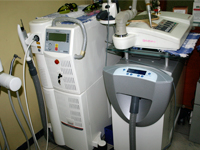 Laser hair removal is a medical procedure that uses laser light to remove unwanted hair. Laser hair removal works by passing a light beam through the skin. The laser targets dark pigment, called melanin, in hair. When the light beam hits the hair follicle (where hair growth originates), the intense heat destroys the hair follicle instantly.
Laser hair removal is a medical procedure that uses laser light to remove unwanted hair. Laser hair removal works by passing a light beam through the skin. The laser targets dark pigment, called melanin, in hair. When the light beam hits the hair follicle (where hair growth originates), the intense heat destroys the hair follicle instantly.
In most cases, laser hair removal slows hair regrowth, but it takes several treatments to provide an extended “hair-free” period. In effect, it is an effective and hassle free method of excess hair management.

